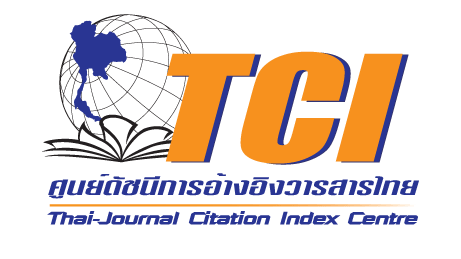MUSIC IN KHUN CHANG KHUN PHAEN LITERATURE BY VAJIRAYANA LIBRARY VERSION
Keywords:
Khun Chang Khun Phaen, Sepha Ballad, Reciting Sepha, Musical Song, Thai MusicAbstract
This article presents the music that appears in the Sepha Ballad book of “Khun Chang Khun Phaen” (Vajirayana Library edition/Revised edition). It is intended for Thai musicians to have a better understanding of the essence of the music in Khun Chang Khun Phaen from the perspectives of a Thai musical historian and provides music content for academic reference. The article’s contents consist of: (1) the essence of reciting a Thai musicali verse; (2) the musical songs of Khun Chang Khun Phaen.
The study found that, originally, Khun Chang Khun Phaen is a Thai folk tale based on the annals of the Ayutthaya period which is later called “Sepha” by the officials. Krom Phra Surasawadi recited it into a fairy tale story that was sung along with the rhythm of “Krap Khu” (Both hands playing a pair of wooden sticks). This became a pattern of reciting “Sepha ballad,” after which several episodes of Khun Chang Khun Phaen were added. During the reign of King Buddhalertla Naphalai (King Rama II), the story of Khun Chang Khun Phaen was recited with the Pipat ensemble. This marked the Formation of “Pipat Sepha Ballad Band” and the popularization of singing the verse to the melody, as evident in the total of 73 lyrics/songs in the Vajirayana Library edition. Furthermore, in each episode, there are other musical contents which can be used as a reference to expanding the perspective of Thai music to be broad and more profound.
References
“กฎหมายตราสามดวง: ประมวลกฎหมายไทยในฐานะมรดกโลก.” ใน กฎมณเทียรบาล ฉบับเฉลิมพระเกียรติ 1, บรรณาธิการโดย วินัย พงศ์ศรีเพียร, 63-182. กรุงเทพฯ : ด่านสุทธาการพิมพ์, 2548.
กฎหมายตราสามดวง ฉบับพิมพ์มหาวิทยาลัยวิชาธรรมศาสตร์และการเมือง แก้ไขปรับปรุงใหม่ เล่ม 1. กรุงเทพฯ : สุขภาพใจ, 2548.
กฎหมายตราสามดวง เล่ม 5. พระนคร : คุรุสภา, 2506.
กรมศิลปากร. บทละครครั้งกรุงเก่า เรื่องมโนห์ราและสังข์ทอง ฉบับหอสมุดแห่งชาติ. พิมพ์ครั้งที่ 3. กรุงเทพฯ : รุ่งเรืองรัตน์, 2508.
ขุนช้าง ขุนแผน (ฉบับชำระใหม่). กรุงเทพฯ : แสงดาว, 2559.
ชูศักดิ์ ภัทรกุลวณิชย์. “โครงสร้างนิยม กับไวยากรณ์ของเรื่องเล่า.” ใน ทฤษฎีกับการวิจารณ์ศิลปะ : ทัศนะของนักวิชาการไทย, บรรณาธิการโดย รื่นฤทัย สัจจพันธุ์, 480. ปทุมธานี : นาคร, 2560.
ดำรงราชานุภาพ, สมเด็จพระเจ้าบรมวงศ์เธอ กรมพระยา. ตำนานเสภา. กรุงเทพฯ : โรงพิมพ์มหามกุฏราชวิทยาลัย, 2497.
ถาวร สิกขโกศล และศิริ วิชเวช. เสภา เสนาะคำหวาน. กรุงเทพฯ : สถาบันไทยคดีศึกษา มหาวิทยาลัยธรรมศาสตร์, 2543.
ประชุมเพลงสวรรค์ บทร้องส่งมะโหรี เพลงสามชั้น เพลงเถา เพลงตับ. กรุงเทพฯ : พานิชศุภผล, 2467.
มนตรี ตราโมท และวิเชียร กุลตัณฑ์. ฟังและเข้าใจเพลงไทย. กรุงเทพฯ : โรงพิมพ์ไทยเขษม, 2523.
ราชบัณฑิตยสถาน. “กรมพระสุรัสวดี.” http://legacy.orst.go.th.
ราชบัณฑิตยสถาน. “ราชมัล.” https://dictionary.sanook.com.
ราชบัณฑิตยสถาน. สารานุกรมศัพท์ดนตรีไทย ภาคประวัติและบทร้องเพลงเถา ฉบับราชบัณฑิตยสถาน. กรุงเทพฯ : อรุณการพิมพ์, 2544.
สนอง คลังพระศรี. “อ่านหนังสือ : เพลงขับในพิธีกรรมความตายสู่มิติบันเทิงของชีวิต.” ใน สุริยวาทิต, บรรณาธิการโดย พิชชาณัฐ ตู้จินดา, 32-39. นนทบุรี : หยินหยางการพิมพ์, 2561.
สุจิตต์ วงษ์เทศ. ขุนช้าง ขุนแผน แสนสนุก. กรุงเทพฯ : พิฆเณศ พริ้นท์ติ้ง เซ็นเตอร์, 2545.
สุจิตต์ วงษ์เทศ. ขับเสภา มาจากไหน?. นครปฐม : มหาวิทยาลัยมหิดล, 2558.
อภิลักษณ์ เกษมผลกูล. “รู้จัก ‘เสภา’ แนว ‘อิคคิวซังแบบไทย ๆ’ จากสมุดข่อยโบราณที่เมืองตราด.” https://www.silpa-mag.com/culture/article_64741.

Downloads
Published
How to Cite
Issue
Section
License
Copyright (c) 2023 College of Music

This work is licensed under a Creative Commons Attribution-NonCommercial-NoDerivatives 4.0 International License.
The copyright of the article belongs to the author. Published articles represent the views of the authors. The editorial team neither necessarily agree with nor take any responsibility for the article.





